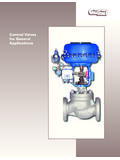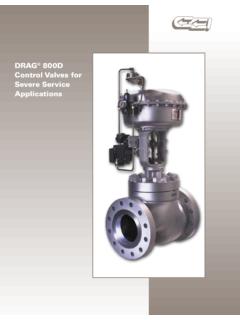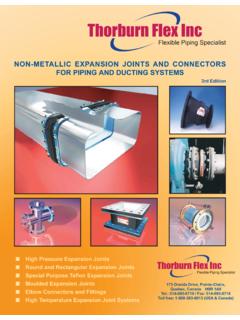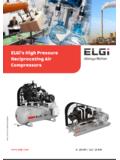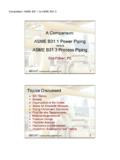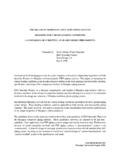Transcription of 100DHPTM CCI DRAG Control Valve For High …
1 100 DHPTM. CCI drag . Control Valve For high pressure Turbine Bypass 2. What is a HP Turbine Bypass Valve ? It routes high pressure , high temperature steam around the HP Turbine, from the main steam line typically to the cold reheat line. In doing so, the HP turbine bypass Valve must perform both pressure reduction as well as temperature Control . pressure reduction is accomplished with the multi-stage trim ( drag ). within the Valve body. The inlet pressure is controlled by an upstream pressure controller, signalling the Valve to modulate to maintain the pressure at the required set point. Alternatively the Valve can be sent a digital signal to quick open or close to Control pressure . Temperature Control is accomplished through the addition of water to the steam to reduce the specific enthalpy of the steam (a process called CCI 100 DHP drag Control Valve for high pressure Turbine Bypass desuperheating). A separate water Valve supplies the correct amount of water to the desuperheating mechanism (typically spray nozzles) within the steam conditioning Valve .
2 A downstream temperature transmitter typically operated in conjunction with a feed-forward algorithm within DCS to dictate the amount of water injected into the steam. Combined pressure Reduction and Desuperheating Ensure Maximum Performance and Reliability The CCI drag 100 DHP range of valves are primarily used in utility power plants for Steam Turbine Bypass to Cold Reheat but potentially can be utilized in similar applications. As reliability and performance are paramount to the operation of the plant, the selection of the drag 100 DHP in the turbine bypass application is critical. By utilizing the energy of the steam in the high velocity region, to desuperheat, steam at required condition can be assured. 3. Requirements for a reliable and high performance Turbine Bypass System Resistance to thermal shock and fatigue The Bypass Valve will be subject to severe thermal shock {200 C (360 F)}. Valve body and trim must be designed to assure reliable operation Maximising power Output and reduced Maintenance Repeatable seat tightness is required to prevent steam leakage that can otherwise be used to generate electricity ad therefore revenue.
3 Excessive seat leakage also results in excessive maintenance and plant shutdown. Must handle severe pressure drops. The Bypass Valve will have to throttle or Control pressure drops of greater CCI 100 DHP drag Control Valve for high pressure Turbine Bypass than 100 bar (2500psi). The Valve trim should have sufficient pressure reducing stages and Control trim exit velocity to prevent premature erosive wear, excessive damaging vibration and noise. TYPICAL CONVENTIONAL REHEAT power PLANT. 4. Valve should have inlet/outlet connections to suit application. Valve inlet and outlet connections should be provided to suit customers piping and to maintain inlet and exit steam velocities to reasonable levels (<80m/s 250ft/s). Control of final temperature The Bypass Valve should have desuperheating system capable of excellent atomization to provide rapid evaporation of high quantities of spraywater required for final temperature Control . Failure to do so can lead to thermal stress of Valve and piping leading to cracking as well as potential flooding or Figure 1: OP sytle nozzles provide superior Cold Re-heat.
4 Primary atomization. Maintenance CCI 100 DHP drag Control Valve for high pressure Turbine Bypass Valve should be in-line repairable for ease of inspection and maintenance. HP BYPASS LAYOUT SHOWING INSTRUMENTATION AND WATER Valve . Figure 2: Good atomization at a wide The drag , high pressure Steam Conditioning Solution range of flow rates. 100 DHPTM by CCI is the optimum high pressure turbine bypass Valve for combined cycle plants, drum boilers and process steam plants. With a compact, robust design that fits into most existing piping arrangements, it can be installed in any orientation. All components, including the flow distributor, are removable through the top of the Valve , making maintenance and inspection quick and easy. The spherical body shape has been designed to avoid material 100 DHPTM delivers superior pressure reduction, 5. temperaure Control , low noise and vibration, and fast response in a complete compact steam Control Valve . concentrations and abrupt changes in wall thickness, minimizing thermal stress in the Valve .
5 Featuring an integrated spring-loaded spraywater nozzle desuperheater manifold at the outlet, the 100 DHPTM. minimizes the downstream desuperheating distance making it extremely compact for high pressure turbine bypass applications. Spring-Loaded Nozzle Desuperheater 100 DHPTM desuperheating features integral spring-loaded water- injection nozzles that optimize water injection over a wide range of flow rates at low pressures. With a rangability limited only by the spraywater Control Valve , the spring-loaded water-injection nozzles vary the water flow rate as required to achieve the fine water droplet size needed for atomization. The spring-loaded water-injection nozzle design provides the smallest CCI 100 DHP drag Control Valve for high pressure Turbine Bypass droplet size possible without steam assist. Figure 3: drag disk stack's multi-stage pressure reduction eliminates noise, Low-Noise drag Trim Technology Designed with Multi- vibration and erosion. Stage pressure Reduction Velocity Control is recognized throughout the industry as the only reliable long-term solution for the elimination of noise, vibration, and erosion.
6 CCI drag is the leading velocity Control technology;. the preferred low-noise Valve solution for pressure reduction. 100 DHPTM features a multi-path, multi-stage design that has been used successfully for over 40 years. The drag disk stack forces steam through a tortuous path of right angle turns to Control the pressure letdown and limit the fluid velocity, thereby limiting noise, and eliminating vibration and erosion. To deliver superior performance, the drag disk stack configuration can be custom designed to the requirements of each application. Accurate Control CCI's long history of advanced technology valves and actuation systems for severe service has led to the development of the most Figure 4: reliable actuation systems available today. CCI has supplied pneumatic and hydraulic actuation systems for over 30 years and has an extensive installed base. Our pneumatic actuation systems can delivery stroke speeds of less than one second while maintaining accurate resolution and Control .
7 The selection of pneumatic or hydraulic actuation is primarily a function of Valve design for the particular application as well as customer preference. A comparison of the factors influencing actuator selection is given in Table 1. 6. Highly reliable, fast, accurate pneumatic and hydraulic actuators provide superior system Control . Improve Plant Efficiency Eliminate Lost Steam During normal operation, any leakage past the turbine bypass Valve means lost revenue. n Steam that does not go through the turbine does not generate electricty or revenue for the plant. n Money spent generating the steam is lost. n Steam leaking past a Valve seat could erode the seat and cause an increase in the leakage rate and maintenance downtime. The CCI 100 DHPTM Valve can be supplied with a Pressurized Seat TrimTM, which provides dependable, repeatable, Class V Shutoff. The special CCI seat configuration ensures that the Valve seat is not exposed to high velocity steam flow, thus protecting the seat and CCI 100 DHP drag Control Valve for high pressure Turbine Bypass assuring tight shutoff the first time and everytime.
8 Table 1: Factors Influencing Actuator Selection Performance CCI Pneumatic CCI Pneumatic Actuator CCI Hydraulic Actuator Attribute Actuator with QuickTrak 1. 1-2 second through Less than 1 second with Very fast, less than Speed accessory components standard pneumatic servo 1 second tree Good with overshoot, Accuracy Excellent with no overshoot Excellent with no overshoot less than 1%. Hysteresis, Linearity Less than 1-3% Less than Less than and Deadband Dead Time on Seat Less than 300-600 ms Less than 100-200 ms Less than 100 ms Calibration/Tuning 1-4 hours Less than 10 minutes3 2-4 hours 1. More information on CCI QuickTrak intelligent digital Valve controller is available upon request and at 2. Optional optimized CCI QuickTrak performance package including remote mounting is recommended for most applications 3. The CCI QuickTrak system allows for fast, accurate and repeatable calibration without an expert technician. 7. Modern Contoured Body Valve body utilizes special drag Trim contour design to minimize Technology thermal stresses for high temperature applications.
9 Valve design utilizes multi-stage drag . technology to eliminate high enegry generated noise, vibration and erosion. CCI 100 DHP drag Control Valve for high pressure Turbine Bypass Removable Flow Distributor Outlet flow distributor to prevent outlet expansion noise and provide uniform flow profile for spray injection. Fully Removable Trim Device is removable to accomodate line No screwed or welded flushing shut-off. components to simplify installation process. Spring Loaded Spray Injection Desuperheating with high turn down spring loaded spray injection nozzles. 8 Use check list to evaluate the benefits of CCI's 100 DHP design Benefits 100 DHPTM Competition Multi-stage velocity Control with up to 10 stages of pressure 1 letdown reduces noise levels to below 85 dBA and eliminates noise-induced vibration which can cause fatigue failure of piping components. high performance, high thrust, fast stroking pneumatic or 2 hydraulic actuation with many years of documented service. Accurate Control and resolution to less than 1 second stroke time for pneumatics (optional).
10 CCI 100 DHP drag Control Valve for high pressure Turbine Bypass Repeatable Class V Shutoff in service and improved plant 3. efficiency through elimination of lost steam. high rangeability of steam flow achievable. Up to 100:1 with 4 pneumatic actuation (1% resolution) and over 100:1 with hydraulics. Rangeability of desuperheating is limited by water Valve selection. Spraywater manifold system allows for multiple attemperation 5. injection points while requiring only one water supply connection. Removable flow distributor outlet cage for quick and easy maintenance. Outlet distributor utilizes Small-Drilled-Hole-Case 6. design which reduces noise levels to below 85dBA. Compact and flexible in design easily fits into most existing 7 piping arrangements. Can be installed in any orientation without additional support for the upper structure. Contoured Valve body designed for frequent start-ups and cyclic 8. operation. Low maintenance costs with quick change trim. No parts are 9. welded or screwed into the Valve body.

